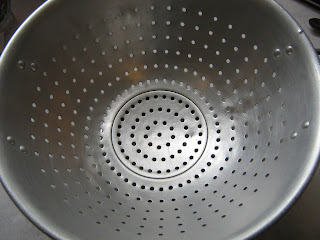A settembre, Jeanette ed io celebreremo il nostro quinto anniversario di matrimonio. Ma eccoci adesso, in vacanze nello Utah. Quindi, stasera abbiamo mangiato la nostra anticipata Cena di Anniversario.
Volevo preparare un secondo che ricorda i grandi piatti dei Monsù, i magnifici cuochi delle Due Sicilie (1816-1861). Con molti di questi piatti, il sugo fa un meraviglioso accompagnamento alla pasta. Così, si può preparare il primo e il secondo simultaneamente.
Ingredienti
pasta che vi piace (noi farfalle)
olio dʼoliva extravergine
1¾ kg “ciampe” di agnello (Parlo degli stinchi. Il mio cognome Ciampa è infatti la parola irpina per zampa. Ovviamente avevo un avo mille anni fa che zoppicava, oppure “inciampava.”)
100-125 g pancetta, affettata allo spessore di 1,25 cm circa)
2 cipolle grandi, squartati
5 spicchi dʼaglio, intere
2 gambi di sedano, dimezzati
2 carote, squartate
3 pomodori secchi al sole
375 mL di un vino rosso che vi piace bere
250 mL brodo casereccio vegetale (oppure acqua)
800 g pomodori pelati, interi
1 crosta dura di parmigiano
sale
pepe
peperoncino
qualche foglia di menta fresca
qualche foglia di basilico fresco
pecorino, frescamente grattugiato
Preparazione
In una grande pentola (più grande di quella che si vede nella foto!), riscaldate dellʼolio. Fate rosolare un poʼ (non completamente) i carni e gli ortaggi tranne i pomodori, con sale e pepe. (Non tentare di far rosolare ogni millimetro di tutto. Solo un poʼ di rosolamento qua e là.) Sfumate col vino. Quando il vino si porta ad ebollizione, aggiungete il brodo. Quando si porta di nuovo ad ebollizione, aggiungete i pelati, il peperoncino, e la crosta del parmigiano. (Non spezzate i pomodori; manteneteli interi.) Se il livello del liquido non sia più alto della carne, aggiungete un poʼ dʼacqua. Coprite e far cuocere a fiamma media per 2 ore.
Ogni tanto, controllate la pentola e aggiungete un poʼ dʼacqua se necessario. Ma nota bene: dopo lʼaggiunta iniziale del vino e del brodo, non aggiungete più vino o brodo, solo acqua. Troppo vino o brodo dominerà il sugo.
Dopo le due ore, spegnete la pentola. Rimuovete lʼagnello, la pancetta, e la crosta del parmigiano. Scartate la crosta. Le carni conservate in una maniera che rimarranno caldi e umidi (e.g., in una teglia, coperta, con un pochettino del liquido dalla pentola, nel forno alla fiamma più bassa).
Il resto dei contenuti della pentola fate passare nel frullatore. Versate in una ciotola, e solo allora aggiungete la menta e il basilico. (Non cucinateli.)
Per il primo, servite la pasta condita con questo stupendo sugo, col pecorino alla tavola. Per il secondo, servite fette dellʼagnello, con un poʼ dello stesso sugo di sopra. Per bere, servite la stessa varietà del vino che avevate messo nel sugo.
Mah! Un sugo più gustoso di questo forse non mangerete mai in vita vostra. Buona cena!
2 gambi di sedano, dimezzati
2 carote, squartate
3 pomodori secchi al sole
375 mL di un vino rosso che vi piace bere
250 mL brodo casereccio vegetale (oppure acqua)
800 g pomodori pelati, interi
1 crosta dura di parmigiano
sale
pepe
peperoncino
qualche foglia di menta fresca
qualche foglia di basilico fresco
pecorino, frescamente grattugiato
Preparazione
In una grande pentola (più grande di quella che si vede nella foto!), riscaldate dellʼolio. Fate rosolare un poʼ (non completamente) i carni e gli ortaggi tranne i pomodori, con sale e pepe. (Non tentare di far rosolare ogni millimetro di tutto. Solo un poʼ di rosolamento qua e là.) Sfumate col vino. Quando il vino si porta ad ebollizione, aggiungete il brodo. Quando si porta di nuovo ad ebollizione, aggiungete i pelati, il peperoncino, e la crosta del parmigiano. (Non spezzate i pomodori; manteneteli interi.) Se il livello del liquido non sia più alto della carne, aggiungete un poʼ dʼacqua. Coprite e far cuocere a fiamma media per 2 ore.
Ogni tanto, controllate la pentola e aggiungete un poʼ dʼacqua se necessario. Ma nota bene: dopo lʼaggiunta iniziale del vino e del brodo, non aggiungete più vino o brodo, solo acqua. Troppo vino o brodo dominerà il sugo.
Dopo le due ore, spegnete la pentola. Rimuovete lʼagnello, la pancetta, e la crosta del parmigiano. Scartate la crosta. Le carni conservate in una maniera che rimarranno caldi e umidi (e.g., in una teglia, coperta, con un pochettino del liquido dalla pentola, nel forno alla fiamma più bassa).
Il resto dei contenuti della pentola fate passare nel frullatore. Versate in una ciotola, e solo allora aggiungete la menta e il basilico. (Non cucinateli.)
Per il primo, servite la pasta condita con questo stupendo sugo, col pecorino alla tavola. Per il secondo, servite fette dellʼagnello, con un poʼ dello stesso sugo di sopra. Per bere, servite la stessa varietà del vino che avevate messo nel sugo.
Mah! Un sugo più gustoso di questo forse non mangerete mai in vita vostra. Buona cena!
| Cipolle fresche da una fattoria locale qua nello Utah. |



















